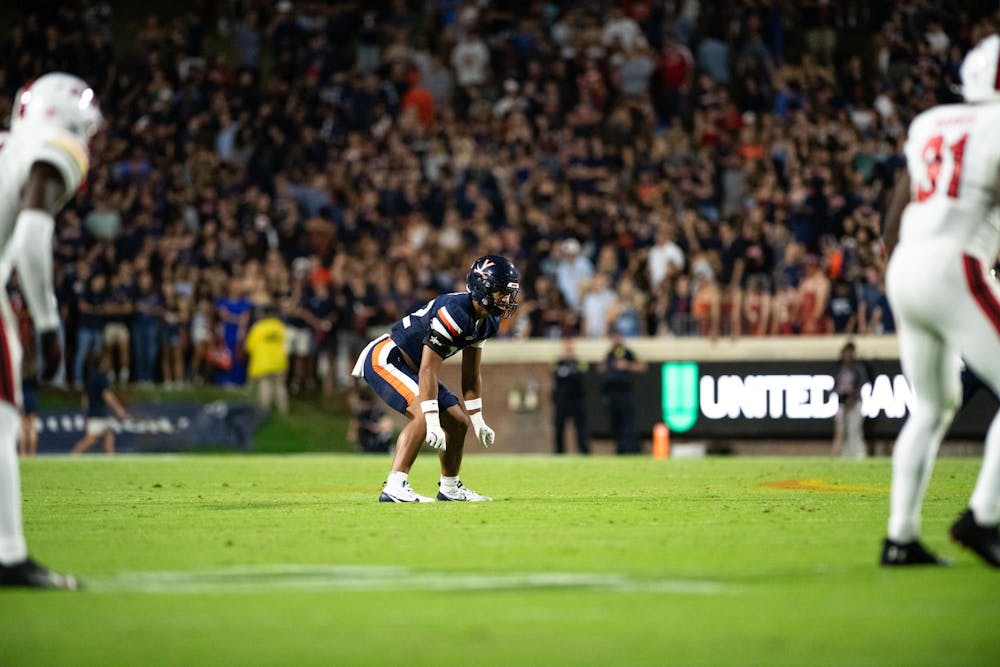Nine transfers, bringing experience from 18 different college football programs — this is the number of defensive backs brought in by Virginia football this most recent offseason. It is more than the total number or transfers welcomed by powerhouse Penn State — the Nittany Lions brought in eight across the entire roster. But, in contrast, the Cavaliers had a leak in the defense that desperately needed to be patched.
Perhaps more than anything else, a football team’s secondary is its safety net. Though the unit can of course make plays of its own, defensive backs are the difference between 20-plus yard gains and wasted offensive downs. They can knock away deep balls, shut down a run game and erase the mistakes of any front seven.
Virginia’s 2024 secondary was not on par with the rest of college football. Few programs suffered more through the air than the Cavaliers, who ranked 125 out of 134 FBS teams in passing yards allowed per game. But 2025 Virginia football has something last year’s team did not — depth, and lots of it.
One could describe the 2024 Cavalier secondary as the Jonas Sanker show. The safety was everywhere, leading the team in tackles, tying for third in sacks, recording an interception and recovering two fumbles, one of which he brought back for a touchdown. But Sanker could only do so much.
His departure, along with those of cornerbacks Kendren Smith and Kempton Shine, dug Virginia into an even deeper hole. Couple that with long-term injuries to returners senior Jam Jackson and junior Dre Walker, and the Cavaliers were left with almost no returning firepower.
Enter nine incoming transfers and five new freshmen. Virginia’s secondary will look entirely different in 2025, but such an extensive platoon swap carries both advantages and drawbacks.
Among the group, there is a tremendous diversity of experience. Graduate safety Christian Charles played 18 snaps in Tennessee’s College Football Playoff loss last season. Junior defensive back Ja’Son Prevard started 11 of 12 games at FCS Morgan State. Two different backgrounds, to say the least.
But as with any large contingent of newcomers, one must ask about fit and culture. Defensive coordinator John Rudzinski noted that this is where the veterans, though small in numbers, make their respective impacts.
“They end up bringing some of the cultural norms that you can’t teach overnight,” Rudzinski said. “And so, they do a great job as far as holding their teammates to the standards.”
Graduate safety Antonio Clary, entering his seventh season with the program, may offer that perspective better than anyone. Jackson and Walker, though injured, can do the same. Mostly new faces, however, will take the field week one Saturday against Coastal Carolina.
Elliott’s recently-released week one depth chart lists graduate transfers Emmanuel Karnley and Jordan Robinson as starting cornerbacks, with Prevard and true freshman Corey Costner both in the spur spot. Graduate transfer Devin Neal and returning sophomore Ethan Minter will start at safety.
Perhaps Virginia’s most interesting secondary addition though is senior Donavon Platt, a transfer from West Point. Platt started at cornerback for a 12-2 Army team that narrowly missed the playoff, in arguably the program’s most successful season of all time. Platt’s contributions do not stop with his play, either. He is an experienced player, one who brings leadership to the locker room and beyond.
“He’s already come in and shown some leadership,” Coach Tony Elliott said. “The guys respect what he’s been through and what he was doing prior to coming here, and I think they appreciate that leadership that he’s going to bring.”
Regardless of who the program uses as its top cornerbacks, the Cavalier depth is a weapon Rudzinski intends to utilize. First and foremost, it allows players to come in fresh.
“You want to have great competitive depth so you minimize exposure for players,” Rudzinski said, “so that they can play as fast as they can snap after snap.”
Moreover, should the Cavalier secondary catch the injury bug like the linebackers, more depth means more insurance. Any loss, though still impactful, is minimized with more pieces to plug in.
Perhaps the greatest question — how will the new secondary mesh with the Virginia defensive line and linebackers? Per Prevard, it will not be a problem.
“I feel like the whole defense is on one accord,” Prevard said.
If he is proven right, and Virginia’s pulled-together secondary works well with itself and other positional units, the Cavalier defense has the potential to become an ACC stalwart.







